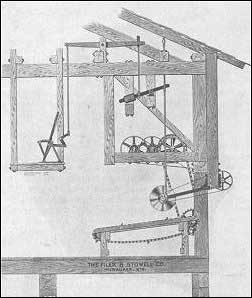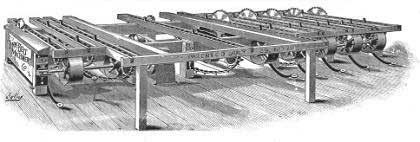The Trimmer
Lumber is trimmed on the ends to produce standard lengths. The boards may also be cut into shorter lengths to eliminate defects. Again, portable mills seldom have this machinery. The simplest form is a single, circular cutoff saw. If daily mill production exceeded 15,000 board feet, an improved machine was necessary.
As the board leaves the edger, it stops. The direction of travel is turned 90 degrees, then it travels onto the trimmer table. This table is a wide as the maximum length of lumber produced by the head saw. Several chains travel upward across this table, equipped with dogs to hold the board as it travels through the trimmer saws.
There are two types of trimmers: overhead or undercut. In either case, the cutoff saws are located at regular intervals to produce standard length boards. The stationary saw is on the right and after a predetermined distance, the other saws are spaced two feet apart.
In the overhead type, the cutoff saws are suspended and balanced above the trimmer table. A pull of a rope, selected by the trimmerman, will lower the saw and cut the board to the desired length; or he can lower more than one saw to cut out a defect. In operation, he looks like an old-fashioned church sexton pulling ropes to ring the bells.

Operating Mechanism For An Overhead Trimmer
(The Filer & Stowell Company)
The undercut trimmer has the saws suspended and balanced under the trimmer table. The spacing is arranged the same as the overhead trimmer, but raising the saw is accomplished by stepping on a pedal under the table. Undercut trimmers are normally used in a mill which produces less than 60,000 board feet of lumber a day. After the boards are trimmed, they are graded, loaded onto push cars, and moved out to the yard for storage and drying.

Undercut Trimmer Table
(The Filer & Stowell Company)
